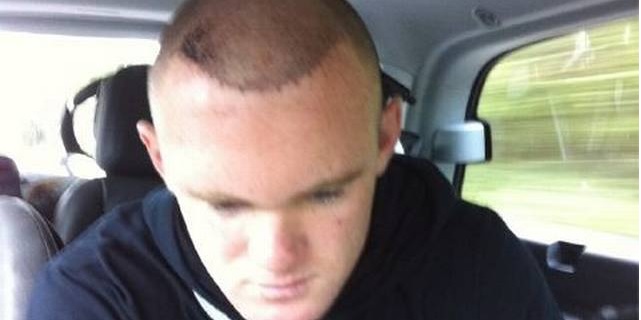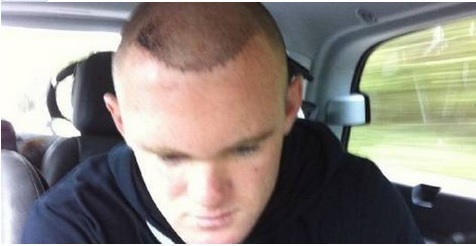
Wayne Rooney has been very open about disclosing his hair transplant procedure. But as a younger patient, he faces risk of continued shedding in his natural hair.
Back in June of 2011, he tweeted this photo of himself right after his first procedure.

The area on top of his head did grow quite nicely. This caused Wayne to be listed as a top celebrity hair transplant example. And as a result, many men started taking an interest in FUE (Follicular Unit Extraction). Clinics noticed about a 25% increase in demand for this procedure among younger men (i.e. under 35)
In June of this year, Wayne underwent a second Follicular Unit Extraction surgery to fill in patches of bald spots. These apparently developed in the regions of his native hair, which were not targeted during his first treatment.
Hair Loss After an FUE Transplant
It is normal for hair to fall out a few months after a hair restoration surgery. These shafts have reached the end of their growth cycle. And new hair is expected to emerge around the fourth month. As long as the procedure was performed properly, the follicles should continue to grow and thrive.
Some people will notice poor yield around the ninth or twelfth month. Full results are expected to manifest by the eighteenth month. And if growth is lacking at this point, it is definitely a sign that many of the follicles did not survive.
However, in Wayne’s case, thinning and loss of hair (as shown above) became evident after a period where his desired results had taken fruition.
A likely explanation is that the donor follicles used were gradually undergoing a process of miniaturization. This is a consequence of male pattern baldness where the follicles shrink due to exposure to compounds in the blood stream like DHT (dehydrotestosterone) and certain forms of prostaglandins.
Dr. Umar explains more about factors that contribute to poor yield and growth after a hair restoration procedure in this video:
There seem to be many people who feel that Wayne should just give up on trying to restore his hair. But really, all is not lost for the soccer player. If most of the donor hairs on the head are falling out due to follicular shrinkage, it is certainly possible to utilize other resources on the body to acquire more resilient hair grafts. Examples would include: the face, neck, chest, abdomen and back.
